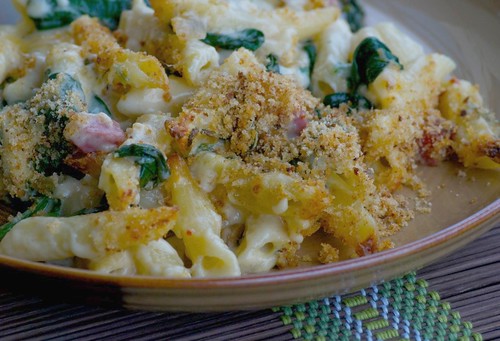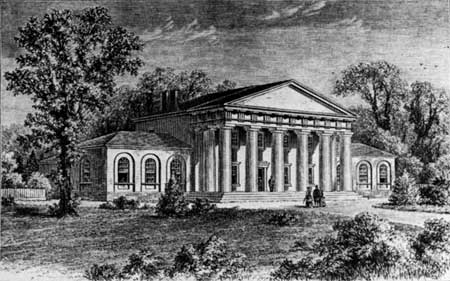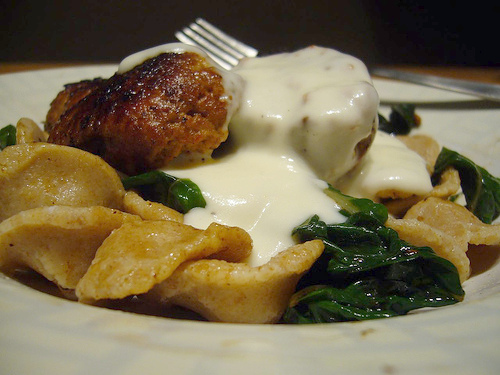

Macaroni and cheese, Traditionally prepared as a casserole, macaroni and cheese is now often prepared stove-top using a packaged food mix.
The dish is essentially a noodle gratin (scalloped potatoes) with macaroni pasta in place of potatoes.
A similar traditional dish in Switzerland is called Älplermagronen (Alpine herder's macaroni), which is also available in boxed versions. Älplermagronen are made of macaroni, cream, cheese, roasted onions, and potatoes. In the Canton of Uri, the potatoes are traditionally omitted, and in some regions, bacon or ham is added.

Macaroni is mentioned in various medieval Italian sources, though it is not always clear whether it is a pasta shape or a prepared dish. However, pasta and cheese casseroles have been recorded in cookbooks as early as the Liber de Coquina, one of the oldest medieval cookbooks. A cheese and pasta casserole known as makerouns was recorded in an English cookbook in the 14th century.It was made with fresh, hand-cut pasta which was sandwiched between a mixture of melted butter and cheese. It was considered an upperclass dish even in Italy until around the 18th century.
"Maccaroni" with various sauces was a fashionable food in late eighteenth century Paris. The future American president Thomas Jefferson encountered the pasta in both Paris and in northern Italy. He drew a sketch of the pasta and wrote detailed notes on the extrusion process. In 1793, he commissioned American ambassador to Paris, William Short, to purchase a machine for making it. Evidently, the machine was not suitable, as Jefferson later imported both macaroni and parmesan cheese for his use in Monticello. In 1802, Jefferson served a "macaroni pie" at a state dinner.
Since that time, the dish has been associated with America and especially the American South. A recipe called "macaroni and cheese" appeared in the 1824 cookbook "The Virginia Housewife" written by Mary Randolph, Jefferson's cousin. one of the most influential housekeeping and cook books of the nineteenth
 century. She was the first recorded person to be buried at what became Arlington National Cemetery , and was a cousin of Mary Lee Fitzhugh Custis, wife to George Washington Parke Custis, Arlington's builder.
century. She was the first recorded person to be buried at what became Arlington National Cemetery , and was a cousin of Mary Lee Fitzhugh Custis, wife to George Washington Parke Custis, Arlington's builder.
Mary's paternal ancestors included Pocahontas, the youngest daughter of Chief Powhatan and her English-born husband, John Rolfe. Randolph was the daughter of Thomas Mann Randolph (1741–1794), a member of the Virginia Convention of 1776, and his first wife, Anne Cary Randolph. Her twelve siblings included Thomas Mann Randolph, Jr. (1768–1828), son-in-law of Thomas Jefferson, who served in the House of Representatives from 1803 until 1807 and as governor of Virginia from 1819 through 1822; and Virginia Randolph Cary (1786-1852), who wroteLetters on Female Character, Addressed to a Young Lady, on the Death of Her Mother (1828).
Mary Randolph married her cousin, David Meade Randolph, of Chesterfield County, Virginia, in December 1780. Moldavia, their Richmond City home, became a center of Federalist Party social activity.
Randolph's influential housekeeping book The Virginia House-Wife (1824) went through many editions until the 1860s. Randolph tried to improve women's lives by limiting the time they had to spend in their kitchens. The Virginia House-Wife included many inexpensive ingredients that anyone could purchase to make impressive meals. Besides popularizing the use of more than 40 vegetables, Randolph's book also introduced to the southern public dishes from abroad, such as gazpacho.Randolph's recipe had three ingredients: macaroni, cheese, and butter, layered together and baked in a 400-degree F. oven. The cookbook was the most influential cookbook of the 19th century, according to culinary historian Karen Hess. In it, Randolph addressed the specific needs of Virginia cooks at a time when wealthy families imported cookbooks from England ignoring the special requirements of the New World. It shows many regional cuisines were firmly established: cornmeal bread, toasting ham, boiling turnip tops, broiled shad, sweet potato pudding, batter cake, hominy, and apple fritters. Similar recipes for macaroni and cheese occur in the 1852 Hand-book of Useful Arts, and the 1861 Godey's Lady's Book. By the mid 1880's, cookbooks as far west as Kansas included recipes for macaroni-based casseroles.Pasta was, however, was still made by hand – a laborious process that often exploited slave labor and servants. Randolph's cookbook addressed housewives in comfortable circumstances. Cooking was done in kitchens kept in a separate building for reasons of safety and summer heat. At its heart was a large fireplace where cauldrons of water and broth simmered during most of the day. A brick oven used for baking was located next to the fireplace. Although the first American pasta "factory" opened in Philadelphia in 1798, most pasta factories emerged with the rapid American industrialization following the American Civil War. Crucial was the development in 1878 of the Marseilles Purifier – a device to improve semolina, the first hydraulic press in 1882, and the first steam powered mill in 1884. Also important in these developments were the the influx of italian immigrants increasing the demand in America for pasta. High class Americans would still purchase imported pasta for the snob appeal. In 1914, an artificial drying process drastically lowered prices of factory pasta. The First World War brought pasta imports to a halt, creating an opportunity for American factories. The number of pasta factories rose from 373 to 575 between 1914 and 1919.
Paralleling this was the introduction of cheesemaking factories. The first American cheesemaking factory was founded by Jesse Williams in 1851. Generic factory cheese, cheddar, became so common it was called "store cheese" or "yellow cheese." The earlier recipes cited by Randolph probably used harder cheeses such as parmesan. These economies of scale were driven both by the move of the population to the cities and the efficiencies of the railroad.
With the lowering of price of the factory-produced product, macaroni, and thus macaroni and cheese, lost its cachet. Fashionable restaurants in New York - even Italian ones - did not serve it.Food science, a new discipline from the 1890s, proclaimed fruits and vegetables were of little nutritional value and cost too much. Simultaneously, the discovery of vitamins caused a new generation to recommend eating pasta. American millers had experienced a decrease in demand as the population moved to cities and did not eat diets based on bread. In the 1920s, the millers promoted macaroni as "the divine food" and sponsored "eat more wheat" campaigns. It was at this time the practice of serving Swedish meatballs with buttered egg noodles emerged.
Kraft foods introduced its packaged dry macaroni and cheese mix in 1937 with the slogan "make a meal for four in nine minutes." It was an immediate success in the US and Canada amidst the economic turmoil of the depression. During the Second World War, rationing of meat and dairy products lead to Kraft's wide popularity. During this time it also became an acceptable entree rather than a side dish. Wartime popularity of the Kraft product lead to common variations of the dish made with processed cheese in the postwar era The 1953 Better Homes and Gardens Cookbook includes a recipe for the dish with Velveeta, which had been reformulated in that year.
The Kraft product is exceptionally popular in Canada where it is the number one selling grocery item and has assumed an iconic status akin to Vegemite in Australia, but it is also seen as a sign of food insecurity for those in lower income levels. In America, the Kraft product is included on the children's menus of Applebee's and Burger King restaurants, and it is a common side or stand alone dish for microwaveable TV dinners. Michelina's, Boston Market, and Stouffer's are some of the more widespread brands. The dish still retains its Southern associations and is a common side at barbeque and soul food restaurants, but it has long held its place in higher end Southern establishments and working class cafeterias. Additional novelties include deep-fried mac and cheese found at fairs and mobile vendors (food carts).
Since the 1990's, various "gourmet" mac and cheese dishes have emerged in fine non-regional American restaurants and bistros. Even more recently, Mac and Cheese only restaurants have appeared in New York City, Monroe, CT, Oakland, CA, Portland OR, St. Louis, MO, among other places.
Macaroni and cheese is generally made with cooked macaroni (elbow macaroni is most common in North America) and a cheese sauce. A very basic recipe is to mix cooked macaroni in a bowl with a can of condensed milk (or sour cream), half a stick of butter, grated sharp cheddar cheese, and pepper to taste. For a creamier sauce, add in a can of cheap Campbell's condensed cheddar cheese soup. Pour the contents into a casserole dish and top it off with yet more cheese. Bake the contents covered at a high temperature until the cheese melts then uncover and broil until the top layer bubbles forming a crust.
The above recipe may be used to make scalloped potatoes by replacing the macaroni with boiled sliced potatoes.
In the French style of cooking, a Mornay sauce is made by adding cheese to a béchamel sauce,
 traditionally made by whisking scalded milk gradually into a roux (equal parts by weight melted clarified butter and white flour), then heated. Another method, considered less traditional, is to whisk kneaded flour-butter (beurre manié) into scalded milk. The thickness of the final sauce depends on the proportions of milk and flour. Cheese — typically a sharp Cheddar often accented with one or more other cheeses, such as Gruyère, Gouda, Parmesan, or Swiss — is incorporated into the sauce either as flavoring or as a substantial portion of the final product. Taste and opinion differ widely, but modern opinion seems to favor substantial amounts of cheese. After mixing together the sauce and cooked macaroni, it may be served immediately — or, alternatively, placed into a casserole dish or ramekins for baking. Most recipes recommend undercooking the pasta if it is to be baked with the cheese sauce, so the end result is not too mushy. The latter method may include various toppings, such as breadcrumbs or crushed crackers
traditionally made by whisking scalded milk gradually into a roux (equal parts by weight melted clarified butter and white flour), then heated. Another method, considered less traditional, is to whisk kneaded flour-butter (beurre manié) into scalded milk. The thickness of the final sauce depends on the proportions of milk and flour. Cheese — typically a sharp Cheddar often accented with one or more other cheeses, such as Gruyère, Gouda, Parmesan, or Swiss — is incorporated into the sauce either as flavoring or as a substantial portion of the final product. Taste and opinion differ widely, but modern opinion seems to favor substantial amounts of cheese. After mixing together the sauce and cooked macaroni, it may be served immediately — or, alternatively, placed into a casserole dish or ramekins for baking. Most recipes recommend undercooking the pasta if it is to be baked with the cheese sauce, so the end result is not too mushy. The latter method may include various toppings, such as breadcrumbs or crushed crackers
No comments:
Post a Comment